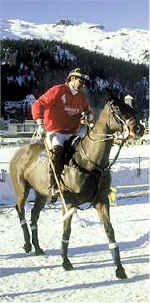

Polo


Polo is another ancient sport, and is thought
to have originated in Persia (Iran)
about 2000 years ago (one source said more than 2,500 years ago). At least
at that time, the sport was played by both men and women. From there it spread to China,
Mongolia,
Japan
, and eventually India, where it was discovered by the
British in the 19th century. Its popularity has since spread all over the
world. It makes exacting demands on the horses, requiring considerable
speed, agility, stamina and courage.
Polo is one of the roughest, toughest games played today, and
playing in the snow adds an extra dimension of excitement. Polo ponies
must be brave and obedient; they must be able to stop and turn like lightning.
(The picture of polo in the snow above is taken from the St. Moritz Polo
Club--the only place in the world where polo is played on grass in summer and
snow in winter!)
Persian art depicts colorful riders on rotund Oriental
horses, unmistakably playing polo--with curiously modern-looking sticks.
The game, portrayed on ancient Persian manuscript illuminations, originated from
"Savlajam," a variety of Tchigan, which was a dangerous mounted form of
tennis. Polo came to England, via
India, in 1869 and still remains a very
popular pastime there. The game was introduced in the United States in
1883.
In Isfahan, more than four centuries ago, the renowned Shah
Abbas used to sit on the high, wooden-pillared balcony of the Aali Qapur, to
watch polo being played below. This beautiful pavilion, and the original
stone goal posts, still remain. But instead of the sandy, hoof-printed
space of long ago, the meidan is now flower-filled, with an ornamental pool
reflecting the slender spires and blue and gold domes of the centuries-old
mosques.
The first public polo game was played in
England
in 1870. It reached
Australia in 1876 and the United
States
in 1883. The United
States
and
Argentina
are among the world's great polo-playing countries today.
The Duke of Edinburgh's enthusiasm for polo matches his skill
and he is now considered one of the better British players. Prince Charles
is also as keen as his father and is becoming an increasingly experienced
player. Their ponies, like most polo ponies since the abolition of the
height limit, are usually between 15.1 and 15.3 hands.
Top-class Polo Ponies are usually
Thoroughbred
or Argentine (Criollo)
x Thoroughbred
(the x stands for "crossed with") costing between $3,000 and
$15,000. They normally winter out, come up toward the end of February, and
from then onward require skilled schooling, mostly twisting and turning at the
canter. They must be fast, obedient, capable of sudden starts, stops and
changes in direction, and be responsive to neck-reining.
High-class polo is possibly the most expensive of all sports,
but an increasing number of clubs are managing to enjoy moderate polo at
reasonable expense. Many pony clubs have sufficient young players to stage
an annual tournament. Almost any well-trained horse or pony will play slow
polo, provided it has confidence in its rider.